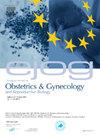高危妊娠血压远程监测的实施;在SAFE@home研究中对患者经历的多中心定量分析
IF 2.1
4区 医学
Q2 OBSTETRICS & GYNECOLOGY
European journal of obstetrics, gynecology, and reproductive biology
Pub Date : 2025-03-10
DOI:10.1016/j.ejogrb.2025.03.028
引用次数: 0
摘要
目的本研究评价高危妊娠患者使用SAFE@home平台进行血压远程监测和症状追踪的体验。我们假设患者会认为远程监测是可用的,以患者为中心,并旨在确定障碍和促进因素,以帮助未来的数字健康规模扩大。方法对11家医院的队列研究进行定量分析。HDP高危患者或已建立HDP家庭的患者每天通过SAFE@home平台监测血压和症状。与常规护理组相比,SAFE@home组的综合不良结局较少(17.2%对21.5%)。采用李克特5分制回答患者满意度和感知护理质量问卷(PSPQC)和以患者为中心的护理问卷(CCCQ)。主要结果是可用性和以客户为中心,≥20%的不一致表明障碍,≥80%的一致表明促进者。结果在606名参与者中,376人(62%)完成了调查。大多数人认为SAFE@home的可用性很高:98%的人认为它对血压监测有用,86-95%的人认为它易于使用。大约68%的人觉得自己更有控制力,81%的人喜欢与个人偏好保持一致,92%的人会向他人推荐SAFE@home。然而,51%的患者认为他们可以独立管理自己的护理,25%的患者不知道在技术问题上与谁联系。结论对高危妊娠患者进行血压和症状远程监测具有较高的实用性和可接受性,可提高患者的参与度和控制性。虽然自主权和技术支持需要改进,但SAFE@home代表了将数字护理整合到产科的可行且可扩展的模式。本文章由计算机程序翻译,如有差异,请以英文原文为准。
Implementation of blood pressure telemonitoring in high-risk pregnancies; a multicenter quantitative analysis of patient experiences in the SAFE@home study
Objective
This study evaluates patient experiences with the SAFE@home platform for telemonitoring of blood pressure (BP) and symptom tracking in patients high-risk pregnancies. We hypothesized patients would perceive telemonitoring as usable and patient-centered and aimed to identify barriers and facilitators to aid future digital health scale-up.
Methods
A quantitative analysis within a cohort study across 11 hospitals was conducted. Patients with a high risk of or established HDP home monitored their BP and symptoms daily via the SAFE@home platform. The SAFE@home group had less composite adverse outcomes (17.2 % vs. 21.5) compared to the usual care group. The patient satisfaction and perceived quality of care (PSPQC) questionnaire and client centered care questionnaire (CCCQ) were answered on a 5-point Likert-scale. Primary outcomes were usability and client-centeredness, with ≥ 20 % disagreement indicating barriers and ≥ 80 % agreement indicating facilitators.
Results
Of the 606 participants, 376 (62%) completed the survey. The majority indicated high usability for SAFE@home: 98% found it useful for BP monitoring, and 86–95% rated it easy to use. Around 68% felt more in control, 81% appreciated the alignment with personal preferences and 92% would recommend SAFE@home to others. However, 51% of the patients felt they could independently manage their care and 25% did not know who to contact with technical issues.
Conclusion
Telemonitoring of BP and symptoms in high-risk pregnancies demonstrates high usability and acceptance among patients, improving engagement and control. While autonomy and technical support require improvement, SAFE@home represents a feasible and scalable model for integrating digital care into obstetrics.
求助全文
通过发布文献求助,成功后即可免费获取论文全文。
去求助
来源期刊
CiteScore
4.60
自引率
3.80%
发文量
898
审稿时长
8.3 weeks
期刊介绍:
The European Journal of Obstetrics & Gynecology and Reproductive Biology is the leading general clinical journal covering the continent. It publishes peer reviewed original research articles, as well as a wide range of news, book reviews, biographical, historical and educational articles and a lively correspondence section. Fields covered include obstetrics, prenatal diagnosis, maternal-fetal medicine, perinatology, general gynecology, gynecologic oncology, uro-gynecology, reproductive medicine, infertility, reproductive endocrinology, sexual medicine and reproductive ethics. The European Journal of Obstetrics & Gynecology and Reproductive Biology provides a forum for scientific and clinical professional communication in obstetrics and gynecology throughout Europe and the world.

 求助内容:
求助内容: 应助结果提醒方式:
应助结果提醒方式:


